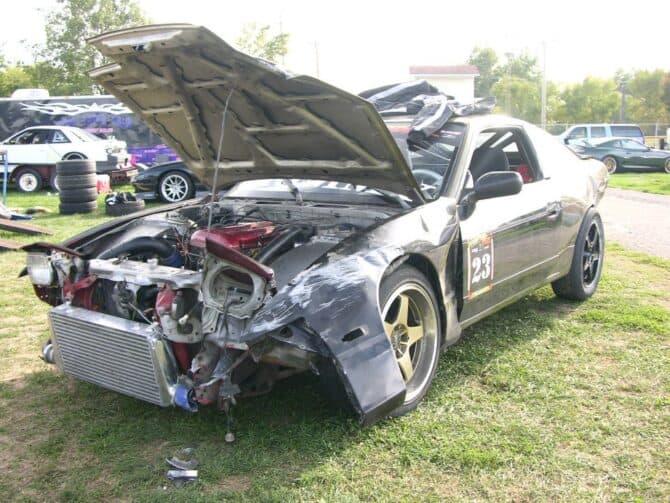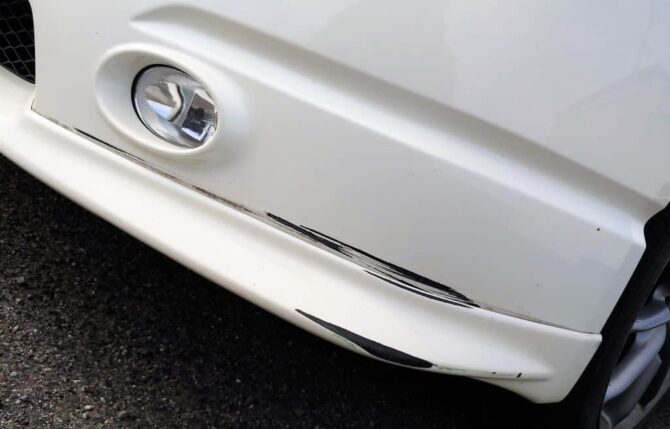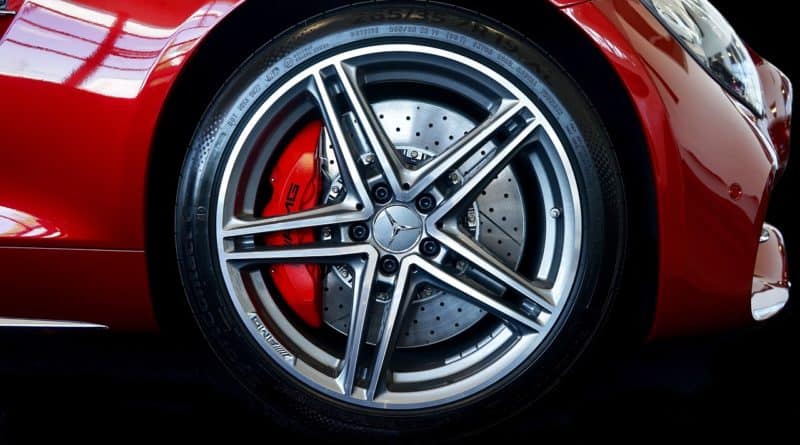Imagine spending hours detailing your ride, only to stumble across a series of scratches, some of which you may have just inflicted yourself. A few choice expletives escape your lips, as you realize that no amount of buffing seems to dissolve the damage. We hate to say it, but chances are those paint scratches are more than clear coat deep, and now you need to figure out how to fix them.
For the average commuter, paint scratches are pretty much impossible to avoid. Whether it’s a negligent driver dinging your door, or swirl marks from your kid’s “WASH ME” message on your pollen-coated rear hatch, scratches and car paint imperfections remain a constant concern. And so people turn to the greatest source of information on the planet: The internet.
Hop online and you’ll find that there are a shit-ton of creative DIY solutions out there for those looking to fix scratches on clear coated and plastic surfaces. Some of these approaches are fairly well thought-out and affective, while others sit on the half-baked end of the marijuana brownie sheet.
In the information below, we’ll identify the top four types of paint scratches, as well as a few approaches that will actually fix them, along with some suggestions for when it might be time to toss in the towel and call in a pro.

Is Removing Paint Scratches Easy?
The only easy thing about this question is its answer: HELL NAW.
Every automotive paint scratch is unique in its own way, and therefore requires different levels of prep care and repair. Even seemingly identical-looking scratches can have varying degrees of paint mutilation, it’s just hard to determine the extent of the damage because it’s lurking beneath the surface.
Automotive scratches can range anywhere from light clear coat imperfections and tiny slivers in wax coatings and paint sealants, to full-blown, metal gouges of catastrophic proportions. Resting somewhere in-between are spider webbing scratches, which can oftentimes be found etched into clear coat, with more extreme cases penetrating into the paint itself.

Identifying Car Paint Scratches
While the type of automotive paint scratch will vary greatly depending upon the degree of damage inflicted, there tends to be one consistent theme within all car scratches: Its source.
Any time the exterior of an automobile is scratched, it is done so by a material that is harder or sharper than the area it is marring. While size and shape definitely have an impact on the level of repair required, it is the depth of the scratch itself that determines the fix.
For example, if you have a scratch that is on a headlight cover, chances are it didn’t require a lot of force in order to get there. Unlike vehicles of yesteryear, modern headlight covers are not made from glass, but instead rely upon a polycarbonate plastic construction. This makes the headlamps of today incredibly resistant to cracking, but also susceptible to things like UV ray damage and surface scratches.
whereas the average headlight lens merely requires a brush with a small tree branch or a poorly cleaned scrubbing mitt for it to look like shit, clear coat scratches require a bit more punch. Painted surface scratches are often the result of contact with hard and/or sharp objects, and require a fair deal of pressure to get past the car’s clear coat.
To determine which repair option is best suited for the scratch at hand, we have rounded-up the four most common types of paint scratches, and included some details on each. Although all of the scrapes listed below are repairable, you will find that the level of restoration that is required will vary depending upon the severity of the scratch itself.
Quick Nerd Note: Although paint scratches are quite different than faded paint, there are some repairs that have the ability to simultaneously fix both. However, be prepared to invest a hefty amount of time, money, and energy into fixing the issue if you choose to tackle the repairs on your own.

Scratch #1 – Clear Coat Scratch
The most commonplace, and easily fixable automotive exterior scratch, is the clear coat surface scratch.
Not to be confused with “paint spider webbing” and other forms of fracturing, clear coat hairline blemishes don’t take much to form, and are commonly caused by things like poor car washing practices and diminutive drying materials.
Rough, or filth-filled sponges, mitts, and cleaning cloths can quickly cause clear coat surface scratches to materialize, and when rubbed in a circular pattern, can create what’s known as “swirl marks.” This is why it is important to always use a clean detailing cloth or wash mitt, and to never buy the cheapest car wash sponge on the shelf.
Quick Nerd Note: Dirt and sand are essentially tiny pieces of earth and stone, while road salt is just flat-out coarse and corrosive, and brake dust is little more than pulverized metallic compounds and various man-made, mortar-like materials. Once applied to a painted surface, and then swirled around under pressure, these forms of media will generate scratches faster than you can crack a beer.

Scratch #2 – Paint Embedded
If a scratch penetrates the clear coat, it more than likely has also embedded into the paint. This level of scratch is when DIY solutions begin to go out the window, for it cannot be buffed out.
Scratches of this caliber often happen when something like another car bumper, guard rail, or heaven forbid, a malicious former lover’s car keys are dragged along a vehicle’s painted surfaces.
Determining whether or not your vehicle has a paint embedded scratch oftentimes merely requires making a visual assessment of the damaged area. If you can see color within the scratch, the gouge got through the clear coat, but it was unable to reach the primer underneath. Which leads us to the next level of automotive surface scratch…

Scratch #3 – Primer Deep
When the scratch goes past the paint, it becomes extremely difficult to repair, at least from a DIY perspective.
While treating these scratches with a quick paint repair solution like a “touch-up pen” may sound tempting, scratches of this nature will often remain visible, even after filling them in with color-matched paint. Even if you may not notice the paint-filled scratch at first glance, chances are you will be able to feel it, so expect to spend some decent dough or a fair deal of time and elbow grease on this fix.
While it is possible to fix scratches of this magnitude on your own, familiarity with automotive body work is crucial in getting this level of scratch to blend seamlessly with its non-scratched surroundings. You will also discover that the use of high-build primers and body filler must often be used on deeper gouges, followed by wet sanding and a full respray of the area. So if this seems to be a bit out of your wheel house, chances are it is not something you should not tackle on your own.

Photo Credit: Micah Wright
Scratch #4 – Bare Metal
If you can see the bare metal beneath the clear coat, paint, and primer, it’s probably time to visit a body repair shop… ASAP.
When metal is exposed to the elements, contaminants that lead to corrosion and oxidation begin to form, and it only get worse when precipitation joins the party. Once wet weather sets in, it’s just a matter of time until these unwelcome party crashers invite even more nefarious characters, like rust, to come over for a visit.
Quick Tip: If you notice a metal-deep scratch on your car, a quick DIY fix can help hold-off the formation of rust via the use of a spray can filled with clear coat. While this should by no means be considered a permanent fix, a quick spritz will lock-out most contaminants and atmospheric moisture until you can get the damage fixed. It may not look pretty, but at least you’ll have a band-aid in place.
Can You Remove Clear Coat Scratches?
Fortunately, clear coat scratches tend to be the most common paint scrape on the planet, and are by far the easiest to remove.
In order to eliminate this form of paint marring, a polishing method known as paint correction must be implemented, which sounds a lot more intimidating than it actually is.
Paint correction typically involves applying a cutting/polishing compound to a surface area via the use of an electric orbital polisher and a microfiber buffing pad. As the pad circulates, the varying grades of compound cut into the clear coat, slowly polishing away the scratch, layer, after layer, after layer, until it is no longer visibly or physically detectable.
Quick Nerd Note: Due to being advertised as a “quick-fix solution,” liquid scratch removers are one of those hassle-free options many people gravitate toward. Unfortunately, these products don’t typically last very long, and when applied in excess, a liquid scratch remover will stand out like a turd in a punch bowl.

hoto Credit: Micah Wright
Repairing Deep Scratches
When the scratch is deeper than the clear coat, your DIY repair options are significantly reduced. Sanding the scratch down to the point where it’s fully level with the surface surrounding it is the most common method for fixing this issue. In most cases, this translates to removing all of the clear coat around the scratch, as well as any surrounding paint, which needless to say, is well beyond beginner DIY territory.
If you can determine that the scratch is indeed deeper than the clear coat, it’s probably best to hand the job over to a professional auto body or detailing expert. Quality results for fixes of this caliber require years of practice, specialized auto body tools, and a fair amount of knowledge on the subject.

Photo Credit: Micah Wright
Why Fixing a Scratch Matters
While many modern vehicles are constructed from various forms of plastic and composite material, things like car doors, hoods, fenders, and quarter panels are still primarily being built out of metal. So unless you’ve got a car that’s made from carbon fiber and titanium, chances are that gouge is going to become a breeding ground for rust in no time.
So if you discover that your car has been scratched in some way, don’t hesitate, because one of the worst things you can do is wait to have it fixed. Taking a proactive stance means protection from the elements, which requires selecting one of the following fixes.
To Serve and Protect
For most DIY devotees, the following methods of “fixing” a scratch remain the gold standard, with one being far more labor intensive than the other.
Option #1: Spray a Clear Coat
The most common method requires buying a can of dual-purpose clear coat (i.e. an all-in-one clear coat and hardener), and spraying the scratch. Just be sure to tape-off the area around the scratch, as it will help reduce the risk of overspray.
Applying car wax, paint sealant, or some other form of temporary paint protection product is another option, just don’t add too much, and use a toothpick on sliver scratches as necessary.
Option #2: Paint Correction
The other form of fixing a paint scratch is paint correction. We briefly spoke about this method earlier, where a polishing compound, orbital buffer, and a microfiber pad are put to work in order to “cut” through the clear coat, and thus level-out the scratch.
If you’ve buffed or polished your car before, you are probably familiar with this process. However, if you are not a polishing pro, or refer to yourself as an intermediate-level detailer, removing scratches via paint correction is probably not the safest approach.
To determine whether or not paint correction is right for you (and your car’s scratches), check-out our in-depth blog article on the subject of paint correction. There, you’ll find step-by-step instructions, fanciful illustrations and imagery, and cunning oratory shenanigans to help you on your journey. Just throw a cold six-pack and some 80s hair metal into the mix and you’ll be set.

Photo Credit: Micah Wright
Parting Shots
Believe it or not, some people remain hell-bent on fixing paint scratches with household items like toothpaste and personal lubricant. These desperate DIY methods have become so commonplace, that we even wrote a blog article on the subject, just to dissuade people from attempting these types of “quick fixes.”
Warning aside, if you’re prepping your car for a ceramic coating, and discover a few scratches, don’t panic. Paint correction procedures aren’t for everyone, so don’t feel bad if you find yourself shelling-out a few hundred bucks for a professional auto body fix. It may seem pricey at the time, but the damage done by a novice attempting to cover-up a scratch is more than likely going to be far more expensive.
Most auto body experts will tell you that the greatest scratch remover is also the cheapest and simplest, for prevention begins with protection. By routinely shampooing, drying, and claying your vehicle, you not only enhance your clear coat and paint’s longevity, but you also reduce the risk of scratches.
Applying a 9H-rated nano ceramic coating product to the vehicle’s exterior will take things even further, as it prevents scratches from forming in the first place. So brush-up on the facts, drive safe, and keep it clean people.













4 comments
Aurea parrilla
I bought this car at Nissan a week later I took it to car wash and the paint came off from the glass on top of hood right on the whole edge on top of glass it’s really moldy on the edges in front what can I do to cover .
I bought this car at Nissan a week later I took it to car wash and the paint came off from the glass on top of hood right on the whole edge on top of glass it’s really moldy on the edges in front what can I do to cover .
Eric
So… I wet sanded and polished a handful of scratches before I did my Armor Sheild IX coating. Two of my polish areas are showing up. Can anyone give me the best way to
“redo” those and redo the ceramic coating?
So… I wet sanded and polished a handful of scratches before I did my Armor Sheild IX coating. Two of my polish areas are showing up. Can anyone give me the best way to
“redo” those and redo the ceramic coating?
Wayne Jordan
I’m sure the scratches can be removed. They are from like dirt. Look like minor scratches that are fine. Need a good polish that can be used. They can be removed if I can find. You have to look closely to see the paint scratches. Just have not found a good polish that works. Any recommendation would be great. Have to clean. Seen a lot of 🚗 with this problem. It doesn’t help the car is black. White car 🚗 u would not seem..
I’m sure the scratches can be removed. They are from like dirt. Look like minor scratches that are fine. Need a good polish that can be used. They can be removed if I can find. You have to look closely to see the paint scratches. Just have not found a good polish that works. Any recommendation would be great. Have to clean. Seen a lot of 🚗 with this problem. It doesn’t help the car is black. White car 🚗 u would not seem..
Claire Masters
I appreciate that you explained that a scratch on the car’s surface will make it exposed to the elements and therefore might invite rusting. My car was keyed by a disgruntled ex last week and I’m not sure what I can do to fix it. I think it would be best to take it to an auto-repair shop soon to have the damage assessed so I would know if it is still fixable.
I appreciate that you explained that a scratch on the car’s surface will make it exposed to the elements and therefore might invite rusting. My car was keyed by a disgruntled ex last week and I’m not sure what I can do to fix it. I think it would be best to take it to an auto-repair shop soon to have the damage assessed so I would know if it is still fixable.